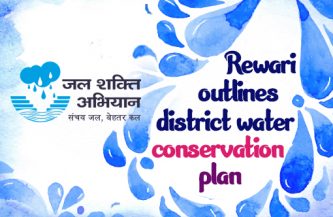Fruit Plantation, Drip Irrigation, Oasis in Block Bhikhi

A number of plantation and water conservation activities have commenced in Bhikhi block of Mansa district in Punjab, as a part of the Jal Shakti Abhiyan (JSA) that is currently being implemented across the country.

This was reported by a team of central government officers, who visited various villages in the block between 9th August and 10th September, 2010. The team comprised Central Nodal Officer, Smt. Anjali Bhawra, Additional Secretary, Ministry of Corporate Affairs; Block Nodal Officer, Shri Kamlesh Kumar Jhell, Deputy Secretary, Department of Empowerment of Persons with Disabilities in the Ministry of Social Justice and Empowerment; and Technical Officer, Shri Harbir Singh.
Their task was to assess the water conservation measures of the district, and initiate suitable action to put in place measures to enhance water conservation and rainwater harvesting; rejuvenate traditional ponds and water bodies; ensure reuse of borewell recharge structures; and promote watershed development and intensive afforestation.
Here is a brief of the villages visited:

Fruit plantation, Ralla village in Bhikhi block (2-4 September): In this village where the water table is at a depth of 14 meters, a fruit plantation has been started on common village land that was lying vacant and fetching no income. The Gram Panchayat passed a resolution and five acres of land was chosen for the plantation in which 500 Guava plants have been planted. Out of 500 plants 40 plants were damaged and these have been replaced with new saplings. This will help the GP to increase their income by around year 2021 and at the same time provide job card holders of the village, regular employment for maintenance of plants under MGNREGS.
Project Oasis, Khokhar Kalan village, Mansa (8-10 September)

In this village in which underground water table stands at 35 feet depth, to solve the menace of stay animals, a cattle pound was constructed. However, water from the cattle shed overflowed into the nearby fields during the monsoon and damaged the crops. To address this, Project Oasis was taken up under MGNREGA in convergence with Talwandi Sabo Power Limited (CSR) and 13th Finance Commission to construct a park on village common land. People from the surrounding villages were also involved in the planning process so that they take ownership, their participation could be ensured and problems related to implementation of the project could be solved at the earliest. This project has helped in water conservation, preventing soil erosion, generating employment, self-sustainability and promoting tourism in the district.


Drip irrigation, irrigation channel, Mansa district (9-11 August, 2019)
In Mansa district where underground water varies from 11 metres to 27 metres depth, farmers with the help of soil conservation department have shifted to drip irrigation in cotton farms, rather than using traditional methods for irrigation. This work has been taken up in 7 villages, across 18.8 acres of land, thereby saving 50 to 70% water that was earlier used for irrigation. Costs pertaining to irrigation, pesticides and manure too have decreased by 10%. In village Kotra Kalan Block Bhikhi, a new irrigation channel measuring 1012 metres in length was constructed under MGNREGA. This has helped in plugging leakages and saving irrigation costs for marginal and small farmers. The project provides benefit to 100 acres of land.


Dense plantation, Khokhar Kalan, Mansa (9-11 August)
In this village where underground water stands at 35 feet, the district administration has taken an initiative to create a Guru Nanak Sacred forest under MGNREGS at the Government Gaushala. This project has been taken up on a sand dune inside the Gaushala. Of the total 200 Sqm taken up, plantation has been done on 160 Sqm. In this forest 550 plants of 29 different species have been planted using Miyawaki methodology with a density of 3.5 trees per square meter, covering 4 layers i.e shrubs, sub-trees, trees and canopy layers. Out of 550 plants planted, currently 537 plants have survived on the site.


1,34,750 saplings, Mansa district (2-4 September)
To mark Guru Nanak’s 550th birth anniversary, 550 saplings of various native plant species will be planted by the Forest Department in every village of Punjab. Saplings for the same have been raised in the nurseries of the Forest Department. In the district of Mansa which has 245 villages, as many as 1,34,750 plants need to be planted. So far, a total of 1,34,750 saplings have been planted in 227 villages and their survival rate is 90% (1,21,275) till date. Since survival of saplings is the main concern, Van Mittars (care takers) have been deputed, each allocated to look after 100 Plants. He will be paid under MGNREGS, as per the survival of plants adopted by him/her. This will help in maximum survival of plants.

Community participation: Work carried out in the villages generally come under government schemes and funds but at times local people can take the lead for the overall development of a village/school etc. One such initiative was seen in Mansa where local youth clubs have planted more than 20000 saplings. In addition, they have created low cost tree guards made of bamboo and installed them around saplings to protect them from stray animals.
Another excellent example of community participation was seen in 10 schools of the district where schools have managed funds from villages to create recharge structures in schools. They will certainly ensure sustainability of the structures.
Meanwhile, the Agriculture Department has taken the initiative to motivate 5 farmers to use extra water from the canal to recharge their borewells.
[NOTE: This blog was first published on https://jalshakti.wordpress.com ]





